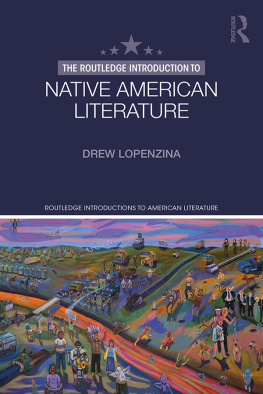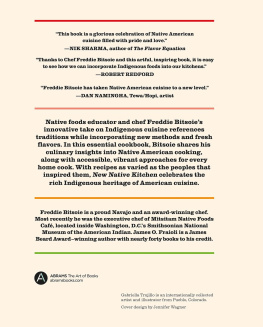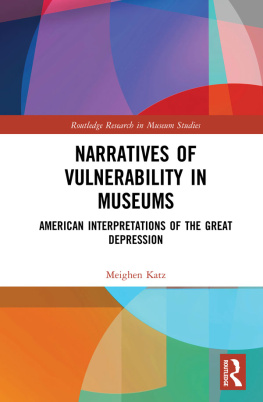Decolonizing Museums
Publication of this book was made possible, in part, by a grant from the Andrew W. Mellon Foundation.
2012 The University of North Carolina Press. All rights reserved
Set in Minion and Aller
Manufactured in the United States of America
The paper in this book meets the guidelines for permanence and durability of the Committee on Production Guidelines for Book Longevity of the Council on Library Resources.
The University of North Carolina Press has been a member of the
Green Press Initiative since 2003.
Library of Congress Cataloging-in-Publication Data
Lonetree, Amy.
Decolonizing museums : representing native America in
national and tribal museums / Amy Lonetree.
p. cm. (First peoples : new directions in indigenous studies)
Includes bibliographical references and index.
ISBN 978-0-8078-3714-6 (cloth : alk. paper)
ISBN 978-0-8078-3715-3 (pbk : alk. paper)
1. Indians of North AmericaMuseums. 2. Indians of North AmericaPublic opinion. 3. Ethnological museums and collectionsUnited States. 4. PostcolonialismUnited States. 5. MuseumsUnited StatesManagement. 6. Museum exhibitsMoral and ethical aspectsUnited States. 7. Racism in museum exhibitsUnited States. 8. Indians in popular culture. 9. Indigenous peoples in popular culture. 10. Public opinionUnited States. 11. United StatesRace relations. I. Title.
E76.85.L66 2012
970.004'97dc23
2012018877
Portions of this work have appeared earlier, in somewhat different form, as Missed Opportunities: Reflections on the National Museum of the American Indian, in American Indian Quarterly 30, no. 3/4 (Summer/Fall 2006): 63245 (revised form reprinted as Acknowledging the Truth of History: Missed Opportunities at the National Museum of the American Indian, in The National Museum of the American Indian: Critical Conversations, ed. Amy Lonetree and Amanda J. Cobb [Lincoln: University of Nebraska Press, 2008], 30527; Museums as Sites of Decolonization: Truth Telling in National and Tribal Museums, in Contesting Knowledge: Museums and Indigenous Perspectives, ed. Susan Sleeper Smith (Lincoln: University of Nebraska Press, 2009), 32237, reprinted by permission of the University of Nebraska Press, copyright 2009 Board of Regents of the University of Nebraska; Diba Jimooyung: Telling Our Story, Permanent Exhibition Review, Ziibiwing Center of Anishinabe Culture & Lifeways, Journal of American History 95, no. 1 (2008): 15862, copyright Organization of American Historians, all rights reserved, excerpted with permission.
cloth 16 15 14 13 12 5 4 3 2 1
paper 16 15 14 13 12 5 4 3 2 1
For Jon
Contents
one
Introduction: Native Americans and Museums
two
Collaboration Matters: The Minnesota Historical Society, the Mille Lacs Band of Ojibwe, and the Creation of a Hybrid Tribal Museum
three
Exhibiting Native America at the National Museum of the American Indian: Collaborations and Missed Opportunities
four
The Ziibiwing Center of Anishinabe Culture & Lifeways: Decolonization, Truth Telling, and Addressing Historical Unresolved Grief
five
Conclusion: Transforming Museums into Places that Matter for Indigenous Peoples
Illustrations
Sovereignty display at the Mille Lacs Indian Museum
Photo wall in the Making a Living section of the new Mille Lacs Indian Museum, 1996
Roadside stand display in the Making a Living section of the new Mille Lacs Indian Museum, 1996
The Four Seasons Room at the Mille Lacs Indian Museum
This Path We Travel exhibit at the National Museum of the American Indian, George Gustav Heye Center, 1994
Moccasin display in the All Roads Are Good exhibit at the National Museum of the American Indian, George Gustav Heye Center, 1994
View of the guns in the Our Peoples: Giving Voice to Our Histories exhibit at the National Museum of the American Indian
Bible case in the Our Peoples: Giving Voice to Our Histories exhibit at the National Museum of the American Indian
Treaty case in the Our Peoples: Giving Voice to Our Histories exhibit at the National Museum of the American Indian
Storm installation in the Our Peoples: Giving Voice to Our Histories exhibit at the National Museum of the American Indian
Interior entryway of the Ziibiwing Center of Anishinabe Culture & Lifeways
Diorama of an ancient petroglyph site at the entrance to the Diba Jimooyung exhibit at the Ziibiwing Center of Anishinabe Culture & Lifeways
Images of ancestors in the Effects of Colonization section of the Diba Jimooyung exhibit at the Ziibiwing Center of Anishinabe Culture & Lifeways
Treaty-signing installation in the Effects of Colonization section of the Diba Jimooyung exhibit at the Ziibiwing Center of Anishinabe Culture & Lifeways
The Creating Beautiful Things in Difficult Times case in the Blood Memory section of the Diba Jimooyung exhibit at the Ziibiwing Center of Anishinabe Culture & Lifeways
Objects and images representing the sovereign status of the Saginaw Chippewa community in the Spirit of Sovereignty section of the Diba Jimooyung exhibit at the Ziibiwing Center of Anishinabe Culture & Lifeways
Preface
This book is about three museumsthe Mille Lacs Indian Museum in Minnesota, the Smithsonians National Museum of the American Indian, and the Ziibiwing Center of Anishinabe Culture & Lifeways in Michiganand their collaborative partnerships with Indigenous communities. My study of the history of the representation of Native Americans in museum exhibitions explores the significance of these three separate institutions, each of which possesses unique and important collections of American Indian material culture, and how they have developed the exhibitions they present. I have worked at two of these museums and have conducted extensive research at all three. Through these experiences, I have witnessed firsthand the complex and important process of developing community-collaborative exhibitions in the late twentieth and early twenty-first centuries.
One of the most vivid memories of my experience in the museum worldand one that has shaped both my understanding of collaboration and the significance of objects to Indigenous communitiestook place in 1995 at the Minnesota Historical Society (MHS). As an exhibit researcher working on Families, an exhibition funded by the National Endowment for the Humanities focusing on Minnesota families that opened at MHS in 1995, one of my responsibilities was to locate a Native American family to be featured in the exhibition. One section of the exhibit dealt with the theme of family reunions and their role in maintaining identity. A colleague, Carolyn Anderson, recommended that we consider featuring the Kittosa Dakota tribal family originally from southern Minnesota. The Kittos own reunions perhaps best exemplified the importance of family reunions in supporting family identity. For the previous ten years, the Kittos had worked on an extensive genealogical project to trace the history of their family and its involvement in the U.S.-Dakota War of 1862.
That war was one of the most searing and significant events in modern Dakota and Minnesota history. In 1862, after suffering the full onslaught of invasion, colonial oppression, broken treaties, and loss of land and lifeways, the Dakota fought a brief war with the United States in the Minnesota River valley, which left hundreds dead.






